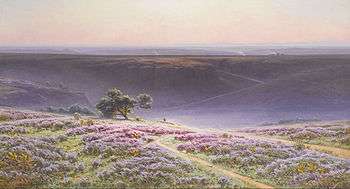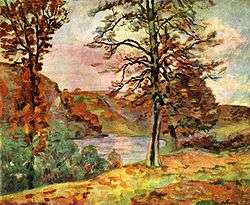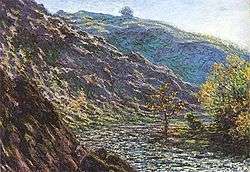Crozant School
The Crozant School (French: École de Crozant) is named after Crozant, a Commune of France at the northern limit of the department of Creuse. It consists of a host of landscape painters who worked from 1830 to 1950 on the banks of the Grande Creuse, Petite Creuse, Sédelle and Gargilesse rivers near the communes of Crozant and Fresselines.

The "Crozant School" is simply a convenient name to designate all those who have found inspiration in the Creuse valleys: it is a "school without a master". In little more than a century, nearly 500 painters frequented the region.[1]
History
Abandonment of neoclassical

At the start of the 19th century, artistic fashion had settled around the neoclassical tradition as exemplified by the work of the painter Jacques-Louis David. Alongside this academicism, the romantic tradition formalized by Gericault, Bonington and Delacroix was gaining momentum.
In 1824, the Paris Salon exhibited some of the works of John Constable. His rural scenes had a decisive influence on younger artists, leading them to abandon the formalism of the time and take their inspiration from Nature. They produced paintings, often of rural scenes, that broke from the dramatic mythological themes.
During the 1848 revolution, the painters that would soon be associated with Crozant school or the Barbizon school got together and deliberately opted to follow Constable's precepts, to make nature itself the subject of their paintings. Among them, Millet spread his vision of landscapes with figures, depicting peasants and farm work. The Gleaners (1857) is a perfect example, showing three peasant busy gleaning after the harvest, without staging or dramatic effects but simply an evocation of the simple life.

Origin of Crozant
Fresselines is located about fifty kilometers from Nohant, the home of George Sand (1804-1876). She and her prestigious guests enjoyed walks in the Creuze valleys around Fresselines and Crozant. She would evoke Crozant or Fresselines in several of her novels: Lettres d'un voyageur (Letters of a traveler),[2] Le péché de Monsieur Antoine (the Sin of Monsieur Antoine)[3] and Jeanne.[4] In 1857 George Sand's friend Alexandre Manceau offered her a small house in Dampierre-Gargilesse ten kilometers from Crozant. She was to spend several visits there. The fame of Crozant and its surroundings attracted many artists.
School without a master
The term "Crozant School" appeared as early as 1864, during the Exposition des beaux-arts, Salon of 1864 (Palais des Champs-Elysées). Since then, many artists have transited through the Valley of the Creuse and especially through Crozant, Fresselines and Gargilesse.[5] The term is a generic since no teacher ever taught in the Creuse valleys.
Similarly, it was not until 1890 that the term "Barbizon School" appeared in the work of Scottish art critic David Croal Thomson entitled: The Barbizon School of Painters. Art historians have disputed the idea that there was ever a "school" at Barbizon.[lower-alpha 1]
The Barbizan school is a set of artists with very different styles who at very different times found inspiration in the Forest of Fontainebleau.
Artists of the Crozant School
Painters

.jpg)
- Jules Dupré (1811-1889)
- Armand Cassagne (1823-1907)
- Claude Monet (1840-1926) visited Fresselines from March to May 1889, where he painted a series on the site of the confluence of the two rivers. He created 23 paintings in the Valley.[6]
- Father Lawrence Guétal (1841-1892).[7]
- Armand Guillaumin (1841-1927), who had the luck to win the jackpot of the National Lottery (1891), was now free from material cares and devoted himself totally to painting. In 1893 he chose Crozant as his favorite residence. Not far from the Crozant church is a bronze bust of Guillaumin.
- Ernest Victor Hareux (1847-1909) is known as a member of the dauphinoise school, but like many of his contemporaries he was involved for a time in the Creuse valleys.[8]
- Ernst Josephson (1851-1906)
- Edouard Pail (1851-1916)
- Maurice Leloir (1853-1940), and the Leloir dynasty
- Alfred Smith (1854-1932)[9]
- Pierre Ernest Ballue (1855-1928), is known as a member of the Barbizon School too
- Léon Detroy (1857-1955)
- Henri Charrier (1859-1950)
- Fernand Maillaud (1862-1948)
- Paul Madeline (1863-1920)
- William Didier-Pouget (1864-1959)
- Eugène Alluaud (1866-1947)
- Clémentine Ballot (1879-1964)
- Anders Osterlind (1887-1960)
- Solange Christauflour (1900-1953)
Author and poet

The poet Maurice Rollinat (1846-1903), godson of George Sand, retired to Fresselines in 1883 to continue his work there. He was surrounded with friends with whom he shared the last years of his life. Maurice Leblanc visited Rollinat, whom he had known in Paris.[10] In 1886, he published l'Abîme (The Abyss), then Paysages et Paysans (Landscapes and Peasants) and a prose collection En errant (Wandering).[11] On Rollinat's death in 1903, Auguste Rodin offered the Fresselines commune a bas-relief entitled "Poet and the Muse". This sculpture is on display on the wall of the village church.
Epilogue
In 1926, a new story began for the banks of the Creuse, which were flooded by the waters of the largest dam in Europe at the time, the Eguzon Dam, for production of hydroelectricity.[12] The new tourist attraction is now Lac de Chambon. The deep gorges lost some of the wilderness character that had appealed to the painters, but the region gained a tourist area in the "Plage de Fougères".
Notes
- This is the view taken by Chantal Georgel in the exhibition "The Forest of Fontainebleau, a great natural studio" at the Musée d'Orsay in 2007
References
- Services DIREN
- George Sand (1838). Lettres d'un voyageur. 1. Meline, Cans. p. 253.
- George Sand (1857). Le péché de Monsieur Antoine. Michel Lévy Frères. p. 294.
crozant+sand.
- George Sand (1844). Jeanne: suivie de Procope le grand. 1 à 2. R. Simon. p. 50.
- "Museonature, Crozant, Les peintres de la Creuse et de Gargilesse". Archived from the original on 2016-03-04. Retrieved 2012-12-05.
- "Claude MONET à Fresselines". Fresselines Hier. Archived from the original on 2012-07-12. Retrieved 2012-02-06.
- GUETAL Laurent. "La Creuse". Joconde. Retrieved 2012-02-06.
- "Paysage; Lansdschaft (Traduction)". Joconde. Retrieved 2012-02-06.
- Hollis Koons McCullough, ed. (2005). "Alfred Smith". Telfair Museum of Art: collection highlights. University of Georgia Press. pp. 156–157. ISBN 0-933075-04-9.
- Le¨Populaire
- "Maurice Rollinat à Fresselines". Fresselines Hier. Archived from the original on 2011-08-11. Retrieved 2012-02-06.
- "Le Barrage d'Eguzon". Berry Sud. Archived from the original on 2011-08-14. Retrieved 2012-02-06.
Further reading
- Chantal Georgel (dir.), La Forêt de Fontainebleau, un atelier grandeur nature, catalogue de l'exposition du Musée d'Orsay (6 mars au 13 mai 2007), éd. RMN, 2007, 242 p. ISBN 978-2711852888
- Christophe Rameix, L'école de Crozant, les peintres de la Creuse et de Gargilesse ,1850-1950, 196 p., éditions Lucien Sauny, 1991 ; réédité en 2002, 200 p. ISBN 2911551877
- Christophe Rameix, Les maîtres de la Creuse, catalogue de l'exposition "Chefs-d'œuvres de l'école de Crozant-Gargilesse,1830-1930", 95 p., éditions des Amis des peintres de Crozant, 1997
- Christophe Rameix, Detroy : œuvres majeures, catalogue de l'exposition "Léon Detroy (1859-1955)", éditions des Amis des peintres de Crozant, 2000
- Catherine Wachs Genest, Christophe Rameix, La Creuse de Guillaumin, catalogue de l'exposition "Guillaumin, 2007", 47 p., musée d'art et d'archéologie de Guéret, Guéret, 2007